Jimmystats: Rostering 2018

We’re off the shores of offseason and wading toward the Signing Day drop-off, and 247 recently released their final 2018 rankings, so I thought now would be a good time to update my big, useful roster database.
apologies for giving Rutgers a competitive advantage
It can tell you fun things, like how this year’s recruiting class stacks up against previous ones:
(it’s like the 2014 one, ratings-wise)
…or the NFL outcome of Michigan recruits by their relative star ratings:
| As Recruit | Players | Rnds 1-3 | Rnds 4-7 | UDFA+ | UDFA | No NFL |
|---|---|---|---|---|---|---|
| ☆☆☆☆☆ | 17 | 9 (53%) | 2 (12%) | 1 (6%) | 2 (12%) | 3 (18%) |
| ☆☆☆☆½ | 64 | 9 (14%) | 12 (19%) | 3 (5%) | 9 (14%) | 31 (48%) |
| ☆☆☆☆ | 110 | 17 (15%) | 16 (15%) | - | 1 (1%) | 76 (69%) |
| ☆☆☆½ | 85 | 2 (2%) | 7 (8%) | - | 1 (1%) | 75 (88%) |
| ☆☆☆ | 113 | 4 (4%) | 7 (6%) | 1 (1%) | - | 101 (89%) |
| ☆☆ | 14 | - | - | 1 (7%) | - | 13 (93%) |
| Walk-on | 26 | 1 (4%) | 1 (4%) | - | - | 24 (92%) |
Or how attrition is going:
(it has stayed relatively low compared to Rodriguez and Carr)
(few players are leaving without degrees)
If you download and play around a bit you can quickly find things like which players each recruiting service adored/didn’t think much of relative to each other:
| Rivals | Scout | ESPN | 247 | |
|---|---|---|---|---|
| Loved
| Steve Breaston | Paul Sarantos | Marques Walton | Benjamin St-Juste |
| Conelius Jones | Austin White | Rueben Riley | Cameron McGrone | |
| Kevin Koger | Andrew Stueber | Junior Hemingway | Nate Johnson | |
| Jeremy Gallon | De'Veon Smith | Ja'Raymond Hall | Oliver Martin | |
| Alex Mitchell | Patrick Omameh | Isaiah Bell | Jaylen Mayfield | |
| Hated
| Ja'Raymond Hall | Kingston Davis | Kevin Koger | Austin White |
| Andrew Stueber | Alex Mitchell | Brandon Smith | Conelius Jones | |
| Brandon Watson | Keith Washington | Dennis Norfleet | Brad Robbins | |
| Paul Sarantos | Gabe Watson | Boubacar Cissoko | Myles Sims | |
| Ronnie Bell | Reuben Jones | Rocko Khoury | Zach Gentry |
--------------------------------
Direct Recruiting Comparisons
There’s also a second table that shows all of the recruiting data that went into my composite rankings, if you want to quickly compare where the sites put Luke Schoonmaker to Sean McKeon (they’re nearly identical):
…or place Cam McGrone among Michigan’s all-time linebacker recruits:
…or settle an argument with the guy who said Mike Hart was “just a three-star”:
(he was only barely)
…or just pull up a quick list of who’s eligible for this year’s NFL draft. I mostly use it to put the new recruits in context. Like it’s good to know Christian Turner is basically tied with Chris Evans, that Aidan Hutchinson ended up almost exactly where Ryan Van Bergen was rated, and that Jarrod Wilson and Gemon Green wound up right where Benjamin St-Juste did (German Green is down in the JT Floyd/Courtney Avery/James Rogers region). Seeing a handful of former players whose careers (and ceilings) I’m familiar with is more helpful to placing a croot than where he stands among the thousands of high schoolers of his own year whom I haven’t seen.
--------------------------------
Starter Data
Lastly I updated the starter data with 2017 starts, which by the way featured a lot of stuff like three tight ends or three fullbacks. Those atypical start formations are more helpful than hurtful—it’s accurate to say that Gentry and McKeon were more active in the passing game, for example, than Eddie McDoom or Nate Schoenle.
You may remember last year was a crazy low bar for starts returning. Things are getting back to normal. Rather than a historically green team Michigan will have a slightly below averagely experienced team:
The big difference you can’t see here is the distribution of OL starts: last year almost all of the returning OL experience was concentrated in one guy; this year it’s spread out among six dudes: Bredeson, Ruiz, Onwenu, JBB, Ulizio, and Runyan.
The last bit highlights a flaw in reading returning starts without context: there aren’t many years in trackable Michigan history in which any of those guys would have gotten extensive playing time. It also hides regular contributors who didn’t technically start—2016 Maurice Hurst being the case example.
Digging down to game-by-game start data gives us a clearer, albeit imperfect, sample of what was on the field. And last year—to the surprise of nobody—it was historically young.
Let’s put those bars in context: the average starter for Michigan last year on both units was younger than a redshirt sophomore. Only twice in the last 20 years did any one unit dip below that mark: the 2008 offense, and the 2009 defense. I’m sure I don’t have to remind you how that went.
The bad news here is the offense at least is in for another year of historical youngness, quite likely falling below even this year. I plugged the following projection of 2018 starts: Patterson (13), Evans (6), Higdon (7), Mason (8), McKeon (11), Wheatley (2), Gentry (7), Eubanks (1), Black (10), DPJ (8), Crawford (1), and an OL of Newsome-Bredeson-Ruiz-Onwenu-Hudson, and it came out at an average year in program of 2.67, barely above 2008.
Does it matter? With the exception of 1997, the peak years do seem to correlate to the teams playing the guys who’ve been around awhile: 1999, 2002, 2003, 2006, 2011, 2012, and 2016. On the other hand Ohio State managed to put up a strong offense in 2016 despite a similarly young roster, though it should be noted they were operating under an experience QB and the young players were holes that got exploited by better teams.
(I never know what to do here with transfers who’ve started at previous stops. Considering the performance of said transfers when they have played, the most accurate thing to do is to just throw that data out—after all they’re new to the system.)
The other interesting thing I can do with starter data is to check personnel shifts. In the past I used it to show the relative mass on the field between coaches. But the Harbaughification of the offense is clear in other ways, like starting more tight ends:
| AVG Skill Position Personnel at First Snap | ||||
|---|---|---|---|---|
| Season(s) | RBs | FBs | TEs | WRs |
| Carr | 0.99 | 0.62 | 1.27 | 2.11 |
| Rodriguez | 1.22 | 0.14 | 0.78 | 2.86 |
| Hoke | 0.98 | 0.45 | 1.12 | 2.45 |
| 2015 | 1.02 | 0.94 | 1.09 | 1.95 |
| 2016 | 1.00 | 0.69 | 1.77 | 1.54 |
| 2017 | 0.92 | 0.77 | 1.92 | 1.38 |
Anyway if you want to download your own copy of my data and play with it, you’re welcome to it. Just share your findings in the diaries.
January 22nd, 2018 at 2:11 PM ^
Was there an "Exit" post or any additional info about Elysee Mbem-Bosse?
January 22nd, 2018 at 2:15 PM ^
umbig11 mentioned in a thread that his locker was cleared weeks before the season even ended.
January 22nd, 2018 at 2:11 PM ^
Jeremy Clark needs his career summary updated.
January 22nd, 2018 at 3:04 PM ^
oops fixed.
January 22nd, 2018 at 2:15 PM ^
Information overload. Can't wait to nerd out and read this after work.
Thanks so much Seth
January 22nd, 2018 at 2:17 PM ^
please list the dates where you will be holding seminars and breakout sessions on all of this data. Will the sessions last 1 week or 2 weeks ? Holy shit ... that is a lot of Jimmystats!
Go Blue !
January 22nd, 2018 at 2:20 PM ^
Good stuff. Any chance you have national benchmarks for your first table with the draft performance by stars?
January 22nd, 2018 at 2:55 PM ^
Thanks!
January 22nd, 2018 at 3:10 PM ^
These are awesome! Could I use these tools to make active charts for the blog? v
January 22nd, 2018 at 3:23 PM ^
No Problem, I have these all set to update from the google sheet nightly. I sent you an email if you had something specific in mind. It's pretty easy to embed the url for any specific view.
January 24th, 2018 at 4:31 PM ^
And there's a free public version available for download to generate this kind of stuff:
January 22nd, 2018 at 2:53 PM ^
so the 2018 class is roughly equivalent to a transition class. Not ideal
January 22nd, 2018 at 3:05 PM ^
For your data Seth,
Spanellis is likely the C.
Ruiz is a G.
Bredeson is kicking out to RT.
Hudson or Newsome likely the other T.
so.. Hudson Onwenu Spanellis Ruiz Bredeson
Maybe Newsome returns...
January 22nd, 2018 at 3:13 PM ^
Not expecting Bredeson to go out to tackle. His problem is pass pro--that doesn't get better against DEs than DTs.
January 22nd, 2018 at 3:18 PM ^
to the coaching staff spreadsheet.
January 22nd, 2018 at 3:22 PM ^
But I didn't think we had any 5-star recruits in this year's class?
January 22nd, 2018 at 3:30 PM ^
McGrone is a 5* to 247 but not in the 247 composite.
ESPN has him listed as a generic 4* (would be the 4th lowest rated player in the suckeyes class)
Rivals has him as a highish 4*
January 22nd, 2018 at 3:33 PM ^
I didn't realize McGrone got the fifth star, good for him.
January 22nd, 2018 at 3:24 PM ^
In the NFL Outcomes tables, probably need to change the "Walk-On" category to "Glasgow"
January 22nd, 2018 at 3:49 PM ^
Hey, speaking of walk-ons, shouldn't Jordan Kovacs be listed as an UDFA? He signed with the Dolphins and played in a bunch of games for them over 3 seasons as a backup DB.
11 tackles and a sack!
January 22nd, 2018 at 3:36 PM ^
My first observation, which is probably obvious to anyone who has been paying attention to the team and recruiting over the years, is that the very top-starred recruits who have ended up not contributing are clustered in the RB position.
Thoughts to why this might be? Poor rankings? Poor coaching? Poor OL-play? Just bad luck? Our run offense for a long while prior to this year (not including Denard) has not exactly been very good, and even a good RB can't do much if there is nowhere to run, unless they are Barry Sanders.
January 22nd, 2018 at 3:49 PM ^
Guys who runs fast on the best team in the state/region/city do not need to learn how to pick up those few extra yards or how to find opening running lanes. That would be one guess.
January 22nd, 2018 at 4:10 PM ^
The problem was that the recruiting gurus took Fred Jackson's evaluations at face value.
January 22nd, 2018 at 4:00 PM ^
Ace's Prospectin Name Ol' Shared Nips?
January 22nd, 2018 at 5:33 PM ^
hurts!
(insert monty python gif)
January 22nd, 2018 at 7:15 PM ^
just a note of caution: Peters, with three years (?) of eligibility left, even if slow to absorb the scheme, still possesses considerable upside. Patterson will have to be a quick study to slot into another historically youthful offensive side and excel.
January 22nd, 2018 at 8:48 PM ^
January 22nd, 2018 at 10:38 PM ^
Always look forward to seeing the experience and age of our players. I knew we were young and inexperienced last year, but got damn. A little thrown off since I guess Hurst isn't in there as a starter but still. It makes the 2008 team look experienced.
January 23rd, 2018 at 7:37 AM ^
Our LB depth is scary good...
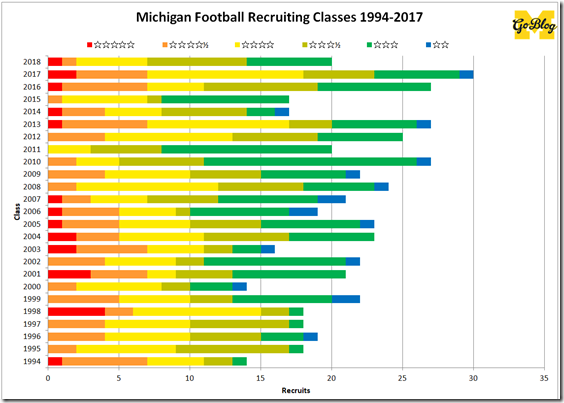

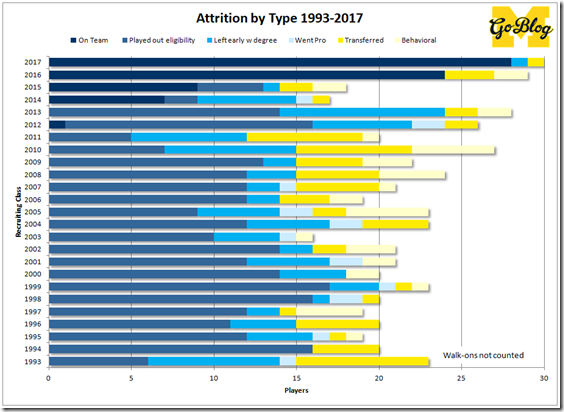



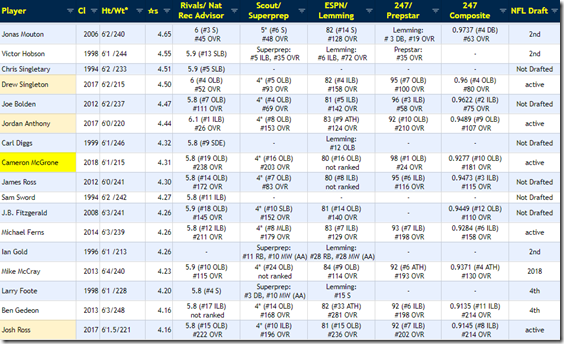

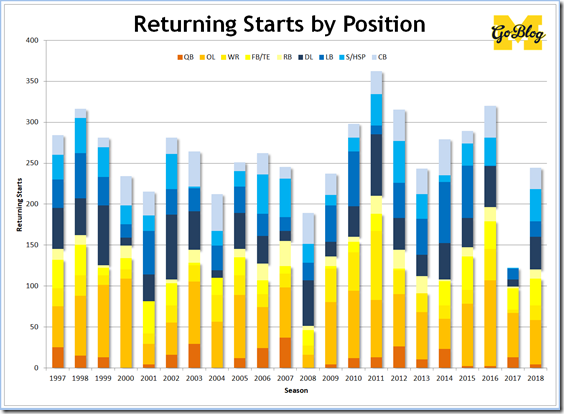

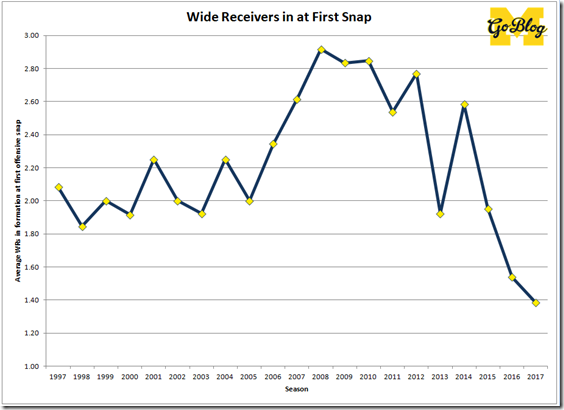

Comments